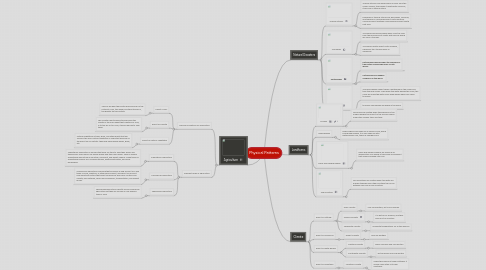
1. Agriculture
1.1. Physical Conditions for Agriculture
1.1.1. Effect of Soil
1.1.1.1. The soil will help the plants grow because of the nutrients. Also, the darker and think the soil is, the greater the soil fertility.
1.1.2. Effect of Climate
1.1.2.1. The climate effects agriculture because the climate is the main agent that creates soil. Also, if its too dry or too cold, it would be bad to farm there.
1.1.3. Effect of Natural Vegetation
1.1.3.1. Natural vegetation is trees, grass, and other plants that are found in the area. Natural vegetation is important because of the effect on soil fertility. they help decompose leaves, grass, etc.
1.2. Different kinds of Agriculture
1.2.1. Subsistence Agriculture
1.2.1.1. Subsistence Agriculture is farmers that work full time to feed their family and themselves. They mainly use animal power and their own labour. There is usually subsistence agriculture in mountain, rainforest, and desert regions. Three types of subsistence farmers are: nomadic herders, shifting cultivators, and small landholders.
1.2.2. Commercial Agriculture
1.2.2.1. Commercial agriculture is farming that produces a long amount of a few types of crop, livestock, or other farm product, and sells it for a profit. Five important factors that affect commercial farms are: location and climate, raw materials, labour and machinery, transportation, and market forces.
1.2.3. Specialized Agriculture
1.2.3.1. Specialized agriculture is pretty much commercial agriculture but they are focued on one specific type of food
2. Natural Disasters
2.1. Tropical Storms
2.1.1. Tropical storms form when warm air rises from the ocean surface, then when it meets with cooler air, it will form a tropical storm
2.1.2. Examples of tropical storms are: hurricanes, cyclones, and typhoons. Hurricanes affect North America. Cyclones affect southern Asia.Typhoons affect south east Asia.
2.2. Tornadoes
2.2.1. Tornadoes are formed when warm moist air rises from the ground and it meets with cold air which will form a tornado.
2.2.2. Tornadoes mostly affect North America, especially the "tornado alley" in Oklahoma.
2.3. Earthquakes
2.3.1. Earthquakes happen when the pressure of two plates release which will create waves.
2.3.2. earthquakes can happen anywhere in the world
2.4. Tsunamis
2.4.1. Tsunamis happen when theres a earthquake in the ocean and then the land cracks. Then when the water passes the crack, the crack will make the water form huge waves which are called tsunamis.
2.4.2. tsunamis can happen anywhere in the world
3. Landforms
3.1. Volcano
3.1.1. volcanoes are created when the pressure of the magma pushes the mount of the volcano which makes the volcano taller and taller
3.2. Shield Region
3.2.1. Shield regions are made up of igneous rock, which is solidified magma, it is also made up with metamorphic rock, which is changed rock.
3.3. Plains and lowland Region
3.3.1. Plains and lowland regions are made up of sedimentary rock which is thick beds of sediment that slowly solidified into rock.
3.4. fold mountain
3.4.1. fold mountains are created when two plate are pushed towards each other and then the rock in between will form a fold mountain.
4. Climate
4.1. Effect of Latitude
4.1.1. Polar Climate
4.1.1.1. Very cold winters, but cool summers
4.1.2. Tropical Climate
4.1.2.1. It is hot for all seasons, and they have a lot of moisture
4.1.3. Temperate Climate
4.1.3.1. moderate temperatures for all the seasons
4.2. Effect of Moving Air
4.2.1. Desert Climate
4.2.1.1. Very dry weather
4.3. Effect of Water Bodies
4.3.1. Maritime Climate
4.3.1.1. warm summers and cool winters
4.3.2. Continental Climate
4.3.2.1. hot summers and cold winters
4.4. Effect of Mountains
4.4.1. Mountain Climate
4.4.1.1. colder than places at lower altitudes. It usually rains often if its near coastlines.
